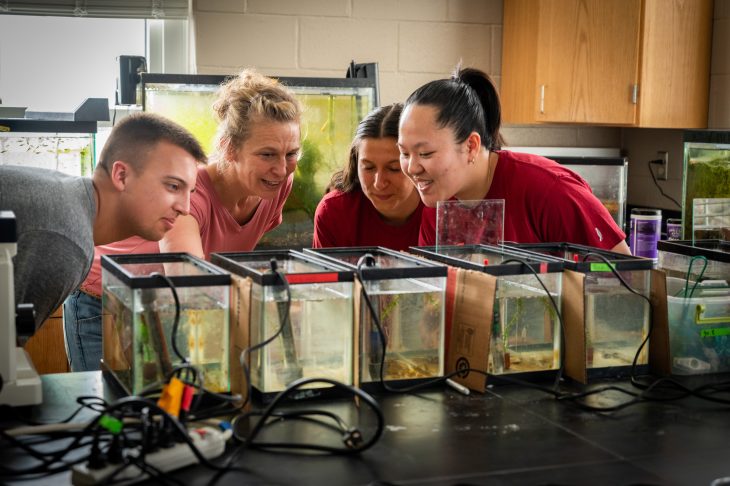
Transylvania Pioneers Makenna Seward ’23, Maggie Spencer ’23 and Graham Thomason ’25 are getting first-hand research experience thanks to Belinda Sly, associate professor of biology. Sly, whose research interests focus on genetics, invited the students to assist her with Betta splendens research. The team, which also consists of a lab coordinator and other faculty members, is exploring the role of the genes controlling pigmentation in the familiar fish — specifically looking at the relationship between pigmentation and other traits.
“If you look at a gene that makes a fish red or gives it spots, there are a million other things the gene could be doing,” Spencer explained. “That’s one of the cool things about biology — how everything is connected.”
The student researchers are trying to improve breeding procedures for the test fish and are using the Ensembl database to compare the betta’s DNA sequencing to the climbing perch, the species’ comparison fish.
They are also exploring research questions, including the role of iron levels in red pigmentation and potential linkages between pigmentation genes and serotonin and dopamine receptors.
Albino betta fish — those with a complete absence of pigmentation — raised some questions as well. “I thought it was really interesting that albino betta fish don’t survive in the wild at all, and in captivity, they have a much lower survival rate than other fish and often have health problems,” Thomason said, adding that these outcomes also led the team to suspect a link between pigmentation and health.
Uncovering a connection between pigmentation and other observable characteristics of the fish could have significant applications extending far past the aquarium. “If we can learn more about the relationship between pigmentations and other phenotypes, that can definitely be applied to other species,” Thomason said, noting that iron deficiency plays a role in many health conditions and genetic anomalies.
“With animal research, you’re trying to understand things about other species to see how it applies or does not apply to humans,” Spencer added. “When we run the DNA sequences, we’re not just looking at the climbing perch and the betta fish, but we’re also looking at mice and humans as well to see gene conservation between all of the species.”
Thomason, who hopes to go to medical school after graduation, appreciates the context that research provides for his coursework. “It’s easy to learn about things, but being able to do research gives you hands-on experience,” he said. “It’s a great opportunity to learn more about your field outside of the classroom and engage with the amazing faculty here at Transy.”
Spencer chose Transylvania in part due to the emphasis on collaborative faculty-student research — a unique opportunity at the undergraduate level. Planning to pursue a career in genetic counseling, she knew that hands-on lab experience working with a collaborative team would help her stand out when applying to graduate programs in biology. “It’s something I really enjoy doing, which makes it feel a lot less like work — it’s fun and interesting,” she said, adding, “I also like that it’s not just isolated to our STEM programs. I have friends in writing, rhetoric and communication and art history who have been published too.”
Research can be a marathon, not a sprint, but, in the words of another famous fish, these Pioneers are determined to “just keep swimming.”
“We’ve done enough background data research to the point where we’re deciding if we want to start manipulating dopamine and cortisol,” Spencer said, noting that the team is also interested in learning more about breeding patterns to try to determine why blue male bettas are substantially less aggressive than their red counterparts, as well as if there is a link between coloring and stress levels in the female bettas. “Our goal is to eventually present our research down the road.”

